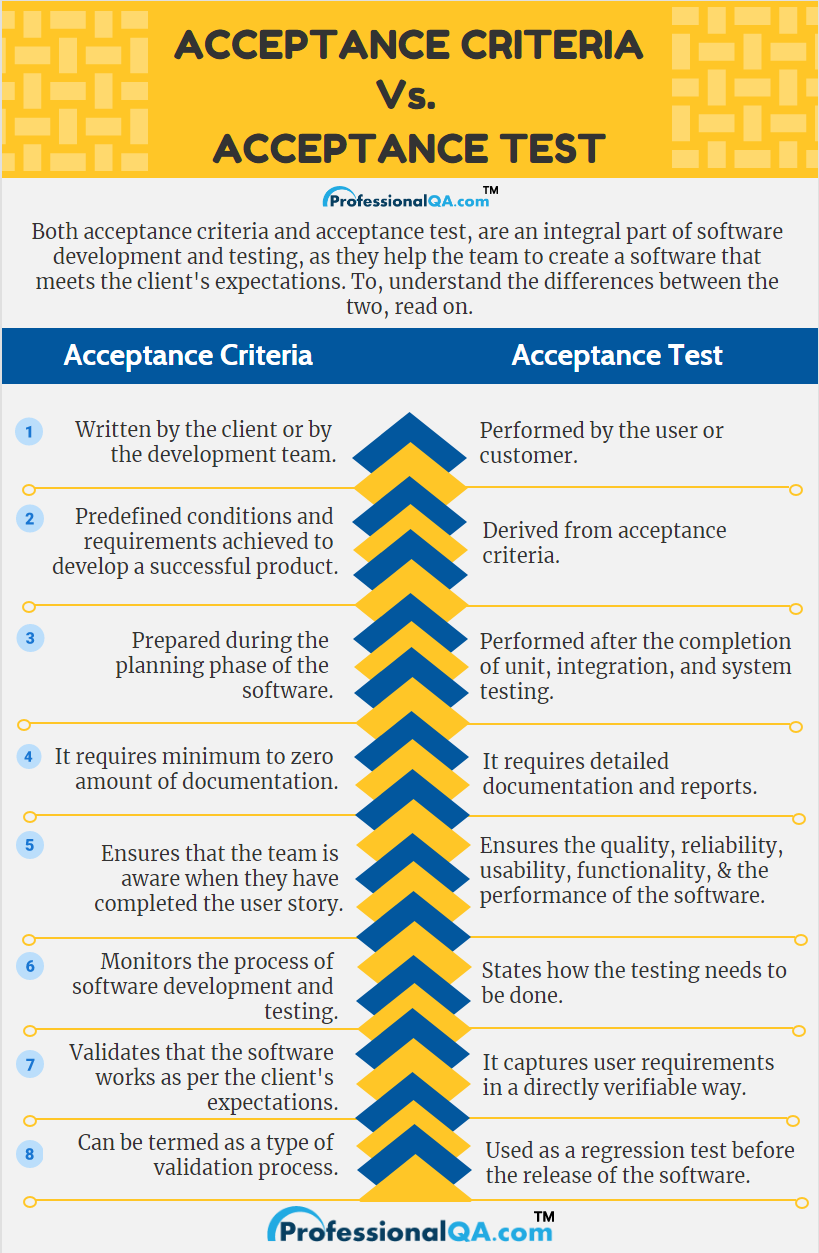

Software testing life cycle is an amalgamation of miscellaneous activities, some of which are usually confused by the team of testers and are used interchangeably. Acceptance Criteria and Acceptance Test are two such activities, which are often confused by new and inexperienced software testers. Even though the difference between these two techniques is quite apparent, provided below is a detailed differentiation of acceptance criteria and acceptance test.
Often overlooked and undervalued by software testers, the acceptance criteria consists of various predefined requirements and conditions, which are required to be met and accomplished, to make the software acceptable for end users and customers. Acceptance criteria validates the development of the software as well as ensures that it fulfills its expected purpose, without any hindrance or issue.
In short, acceptance criteria can be termed as a validation technique, which ascertains every aspect of the functional and nonfunctional requirements of the software and ensures that it meets the specified acceptance criteria accurately.
Acceptance criteria for a software covers three major components- functional, non-functional, and performance criteria. All these help validate the effectiveness and efficiency of the software and enable the team to build a software that offers remarkable functionality and delivers optimum services.
A significant part of software development and testing process, acceptance criteria helps develop a software that meets all the requirements stated by the client before the inception of the process. Moreover, it is used by both software developers and testers to validate the functionality and performance of the software. Other uses of acceptance criteria are:
Acceptance testing is a salient testing technique, which is executed after the culmination of software testing process and prior to the release of the software in the market. It ensures compliance of the software with the stated requirements and validates its quality. Performed at client’s or user’s site, this type of testing ensure optimum user experience and is executed once unit testing, integration testing and system testing is completed. Moreover, this type of testing makes sure that the software fulfills the acceptance criteria and delivers expected services.
Acceptance testing can be categorized into six types, each of which is focused on testing different components and features of the software. These types of acceptance testing are:
The main objective of acceptance testing is to ensure the quality of the software and to validate that no defects are left unresolved, which can hamper the performance as well as the functionality of the software. Other reasons for performing acceptance testing are:
From the above discussion, we can easily understand that acceptance criteria and acceptance test, though interrelated, are not interchangeable and are two different processes. To highlight this fact, below are the features and characteristics of these two processes:
| Acceptance Criteria | Acceptance Test |
| 1. It is either written by the client or by the development team. | 1. It is performed by the user or customer. |
| 2. These are the predefined conditions and requirements that are achieved to develop a successful product. | 2. Performed after the completion of unit, integration, and system testing. |
| 3. Defines what needs to be done during the process of development and testing. | 3. Acceptance test is derived from acceptance criteria. |
| 4. Defines the behaviour of the system. | 4. States how the testing needs to be done. |
| 5. It requires minimum to zero amount of documentation. | 5. It captures user requirements in a directly verifiable way. |
| 6. Prepared during the planning phase of the software and prior to the development phase. | 6. Black box testing is used for acceptance testing, which means it is not scripted, but is ad-hoc. |
| 7. Validates that the software works as per the expectation of the client. | 7. It is implemented in the development phase. |
| 8. Can be termed as a type of validation process. | 8. This type of testing requires detailed documentation and reports. |
| 9. Ensures that the team is aware of when they are completed with the user story. | 9. Used as regression test prior to the release of the software. |
| 10. Monitors the process of software development and testing. | 10. Quality assurance plays an important role in this type of testing. |
| 11. Validates higher level of customer satisfaction. | 11. The code is implemented either by the developers or the testers. |
| 12. These are required to be short and concise. | 12. Ensures the quality, reliability, usability, functionality, as well as the performance of the software. |

Both, acceptance criteria and acceptance test, are an integral part of software development and testing. They assist the team to create a software that meets the requirements and specifications, defined by the client or other stakeholders of the project. Moreover, it verifies that the end product delivers expected results and services. Hence, with the assistance of these two, an organization can guarantee the success of their software product.
Advertisement: